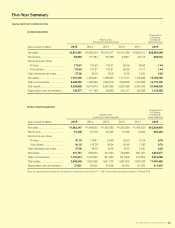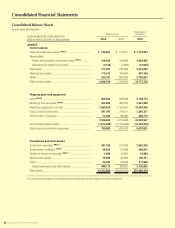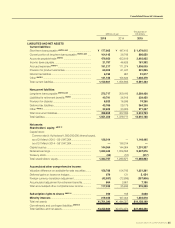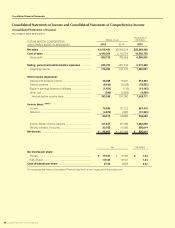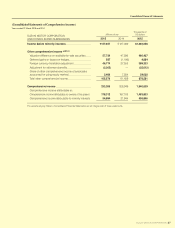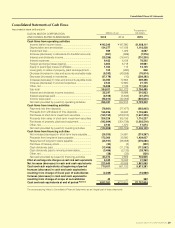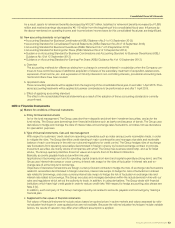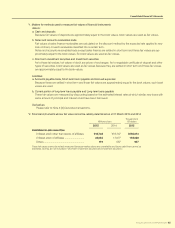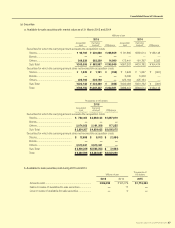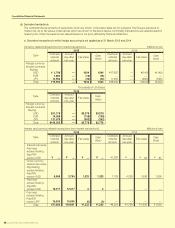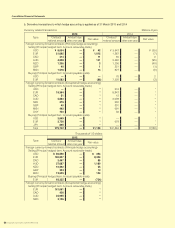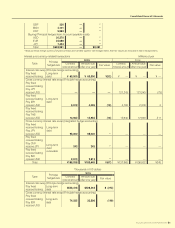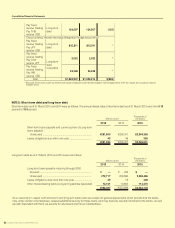Suzuki 2015 Annual Report Download - page 45
Download and view the complete annual report
Please find page 45 of the 2015 Suzuki annual report below. You can navigate through the pages in the report by either clicking on the pages listed below, or by using the keyword search tool below to find specific information within the annual report.
Consolidated Financial Statements
SUZUKI MOTOR CORPORATION 43
As a result, assets for retirement benets decreased by ¥10,357 million, liabilities for retirement benets increased by ¥1,885
million and retained earnings decreased by ¥8,118 million from the beginning of this consolidated scal year. Inuences by
the above-mentioned on operating income and income before income taxes for this consolidated scal year are insignicant.
(b) New accounting standards not yet applied
• Accounting Standard for Business Combinations (ASBJ Statement No.21 of 13 September 2013)
• Accounting Standard for Consolidated Financial Statements (ASBJ Statement No.22 of 13 September 2013)
• Accounting Standard for Business Divestitures (ASBJ Statement No.7 of 13 September 2013)
• Accounting Standard for Earnings Per Share (ASBJ Statement No.2 of 13 September 2013)
• Guidance on Accounting Standard for Business Combinations and Accounting Standard for Business Divestitures (ASBJ
Guidance No.10 of 13 September 2013)
• Guidance on Accounting Standard for Earnings Per Share (ASBJ Guidance No.4 of 13 September 2013)
a. Overview
The accounting methods for difference arising from a change in ownership interest in a subsidiary when the Company con-
tinues to have control because of additional acquisition of shares of the subsidiary, treatment of acquisition-related costs,
expression of net income, etc. and expression of minority interests to non-controlling interests, provisional accounting treat-
ments and others have been revised.
b. Application date
These accounting standards will be applied from the beginning of the consolidated scal year on and after 1 April 2015. Provi-
sional accounting treatments will be applied to business combinations to be performed on and after 1 April 2015.
c. Effect of applying accounting standard
The effect in the consolidated nancial statements as a result of the adoption of these accounting standards is currently
unconrmed.
NOTE 4: Financial Instruments
(a) Mattersforconditionsofnancialinstruments
a.Policyfornancialinstruments
As for the fund management, The Group uses short-term deposits and short-term investment securities, and as for the
fund-raising, The Group uses borrowings from nancial institutions such as banks and issuance of bonds. The Group uses
derivatives to hedge and manage the risks of interest rates and exchange rates uctuations, and does not use derivatives
for speculation purposes.
b.Typeofnancialinstruments,risksandriskmanagement
With respect to customers’ credit risks from operating receivables such as notes and accounts receivables-trade, in order
to mitigate the risks, The Group identies credit standing of major counterparties and manages due date and receivable
balance of each counterparty in line with our rules and regulations for credit control. The Group hedges risks of exchange
rate uctuations from operating receivables denominated in foreign currency by forward exchange contract in principle.
Investment securities are mainly stocks of companies with which The Group has business relationship, and as for listed
stocks, The Group quarterly identies those fair values and reports them to the Board of Directors.
Basically, accounts payable-trade is due within one year.
Applications of borrowings are fund for operating capital (mainly short-term) and capital expenditures (long-term), and The
Group uses interest-rate swaps or cross currency interest rate swaps for the risks of uctuation in interest rate and ex-
change rate of some long-term borrowings.
Objectives of derivative transactions are foreign currency forward contracts to hedge the risks of exchange rate uctuations
related to receivables denominated in foreign currencies, interest rate swaps to hedge the risks of uctuations in interest
rate related to borrowings, and cross currency interest rate swaps to hedge the risk of uctuation in exchange rate and
interest rate related to borrowings. The Group executes and manages derivatives within the actual demand in line with our
rules and regulations which set out the authority to trade. In addition, in using derivatives, The Group deals with nancial
institutions which have high credit grade in order to reduce credit risks. With respect to hedge accounting, also please see
Note 2 (k).
In addition, each company of The Group manages liquidity risk related to accounts payable and borrowings by making a
nancial plan.
c.Supplementtofairvaluesofnancialinstruments
Fair values of nancial instruments include values based on quoted prices in active markets and values assessed by ratio-
nal valuation techniques in case quoted prices are not available. Because the rational valuation techniques include variable
factors, the results of valuation may differ when different assumption is applied.


